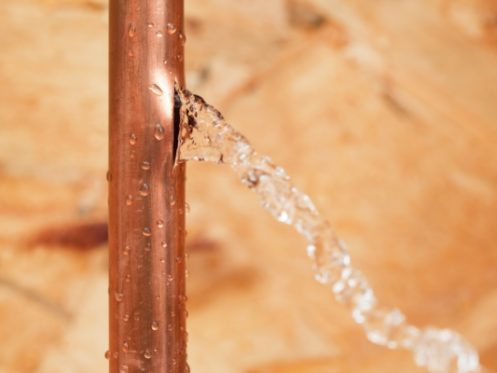Plumbing leaks are something every homeowner dreads. When a leak is present, at the very least it will increase your monthly water bill. Even a seemingly minor leak can waste many gallons of water a day. Leaks inside walls, ceilings, or floors can also cause serious water damage that may require extensive construction to repair. Mold and mildew are other serious problems that can result from leaks, which has the potential to harm your health. Plumbing slab leaks can be even worse as they can cause major structural damage and potentially lead to your home’s foundation buckling.
If you suspect that your home has a plumbing leak, you should immediately call a licensed plumber. The sooner you get the leak detected and repaired, the less chance there is of mold growth and major structural damage. The only issue is that many leaks are quite small and, therefore, difficult to detect without specialized equipment. Therefore, you should always be alert and watch out for any signs that can indicate you have a plumbing leak.
Using Your Water Meter to Identify Plumbing Leaks
Most newer water meters have a leak indicator. The indicator is usually a silver disc or triangular dial that spins whenever water is running. To check if you have a leak, all you need to do is make sure no water is turned on inside or outside and then check the water meter. If the indicator is still rotating, it indicates that water is still flowing due to a leak.
If your water meter is old, it may not have a leak indicator, but you can still use it to detect leaks. After turning all the water off, check the meter to see if the numbers are still rising. If there is a major leak, you will see that the numbers are still ticking up quickly. Minor leaks will cause the numbers to rise more slowly. For this reason, you should shut all your fixtures off and write down the current meter reading. Keep the water off for an hour or two and then look to see if the reading is the same. If the numbers have increased at all, then there is a leak somewhere in your plumbing system.
You should also make sure to monitor your monthly water bill for any unexpected spikes. If your water usage unexplainably goes up from one month to the next, it is most likely due to a leak.
Identifying Leaks in Walls and Ceilings
If you notice any signs that indicate you have a leak, determining the approximate location will make it easier for a plumber to find and fix it. Therefore, you should always stay alert for any potential signs that can indicate a leak. Yellow or brown water spots or black mold spots on the ceiling or wall are obvious signs of a leak. The same is true if your paint is bubbling or the wallpaper is coming loose.
You should also listen for any dripping sounds or water flowing through your pipes when none of your plumbing fixtures or appliances are in use. Moldy or musty odors are also potential signs of a leak, but this could also be caused by another issue such as high indoor humidity.
How Are Slab Leaks Identified?
Slab leaks are usually much harder to spot since they occur underneath the building’s foundation. Any cracks in the foundation can indicate a slab leak, and the same is true for soft spots in the flooring or if the flooring is raised or warped. Noticeable hot spots on the floor also typically indicate a slab leak.
If you suspect you have a slab leak, a plumber should be able to quickly pinpoint its location using specialized equipment. Ground microphones can be used to listen for any sounds of dripping or running water. Remote cameras are also used to inspect the pipes underneath the foundation for any signs of a leak.
Leaky Faucets, Toilets and Appliances
A leaky faucet, showerhead, or toilet that slowly leaks water from the tank into the bowl may not seem like a big issue, but they can waste much more water than you might imagine. The EPA estimates that a faucet that drips once per second could potentially waste as much as 3 million gallons of water in a single year. The good news is that these issues are easy to fix and something you can probably do on your own.
A leaky faucet will usually need to be replaced, while a shower that constantly drips can be fixed by replacing the shower valve cartridge. For a toilet that leaks water from the tank, the issue is usually as simple as replacing the flapper. You can also test for this kind of a leak by putting a few drops of food coloring or a toilet dye tablet into the tank and then waiting a few minutes to see if the coloring ends up in the water in the bowl.
Dishwashers, washing machines, water heaters, water softeners, and water filtration systems can also develop leaks. Some of these leaks can be fixed while others will require the appliance to be replaced. In some cases, you won’t see any visible water, but you may start to notice soft spots on the floor or damage to the flooring. If you suspect you are experiencing any of these leaks, you should immediately shut off the water supply to the appliance until you can have it inspected by a plumber.
Solutions for Repairing a Plumbing Leak
Leaks in walls or ceilings are usually easy to fix. After pinpointing the location of the leak, a plumber will need to cut a hole into the wall or ceiling to access the plumbing. They will then shut the water off and replace the section of the pipe that is leaking. If the pipe has been leaking for some time, it will usually be necessary to replace the insulation. More serious leaks may also require some of the studs to be cut out and replaced if they are rotten or otherwise damaged due to the water. If mold is present, you will also need to have mold remediation done once the leak has been fixed.
Slab leaks are obviously a bit more difficult to repair since they occur under the foundation. One option is pipelining, which uses an inflatable, epoxy-coated tube. The tube is run through the damaged pipe and then inflated. The epoxy then bonds with the pipe and hardens to repair any damage.
If the pipe is more severely damaged, repiping is usually the better option. This method will require demolishing a part of the floor so that new pipes can be installed. The old pipes are then bypassed to ensure the system is again leak-free.
Professional Leak Detection and Repair Services
If you suspect you have a plumbing leak, our licensed plumbers at Plumbtree Plumbing & Rooter specialize in leak detection. We will use our years of experience and sophisticated equipment to quickly detect the leak and then determine the best option for repairing it. Some issues, such as an overflowing toilet or burst pipe, are much more serious and require immediate attention, which is why we offer 24/7 emergency plumbing services. We also provide a full range of other plumbing and rooter services to customers in San Jose and throughout Silicon Valley. Give us a call today to get your leaking plumbing problems taken care of once and for all.

